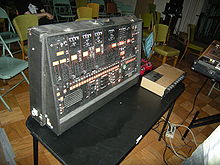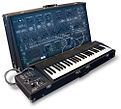ARP 2600
This article has multiple issues. Please help improve it or discuss these issues on the talk page. (Learn how and when to remove these messages)
|
| ARP 2600 | |
|---|---|
 Steve Fisk's ARP 2600 (without keyboard) | |
| Manufacturer | ARP Instruments, Inc. |
| Dates | 1971-81, 2020 |
| Technical specifications | |
| Polyphony | Monophonic |
| Timbrality | Monotimbral |
| Oscillator | 3 |
| LFO | 1 |
| Synthesis type | Analog subtractive |
| Filter | 24 dB/octave low-pass (1) |
| Attenuator | ADSR and AR |
| Aftertouch expression | None |
| Velocity expression | None |
| Storage memory | None |
| Effects | Spring reverberator |
| Input/output | |
| Keyboard | 49 |
| External control | CV/Gate |
The ARP 2600 is a semi-modular analog subtractive audio synthesizer, designed by Dennis Colin for Alan R Pearlman, and manufactured by his company, ARP Instruments, Inc. as the follow-on version of the ARP 2500.
Features
Unlike other modular systems of the time, which required modules to be purchased individually and wired by the user, the 2600 was semi-modular with a fixed selection of basic synthesizer components internally pre-wired. The 2600 was thus ideal for musicians new to synthesis, due to its ability to be operated either with or without patch cords. On its initial release it was heavily marketed to high schools and universities.
There are three basic versions of the ARP 2600. The first, dubbed the "Blue Marvin", was housed in a light blue/grey metal case with a keyboard that mated to the synthesizer, and was assembled in a small facility on Kenneth Street in Newton Highlands, Massachusetts, during ARP's infancy as a company. Later ARP 2600s used vinyl covered wood construction with metal corners for both the synthesizer and keyboard making it a more durable and portable instrument. Early versions contained an imitation of Robert Moog's 4-pole "ladder" VCF, later the subject of a threatened (though ultimately nonexistent) lawsuit[citation needed]. Finally, in order to fit in with the black/orange theme of ARP's other synthesizers, the ARP 2600s were manufactured with orange labels over a black aluminium panel. The mid-production grey 2600 models featured many changes amongst themselves. Changes in circuitry and panel lettering provided at least three different grey panel models.
Alan R. Pearlman provided synthesizers to well-known musicians, such as Edgar Winter, Pete Townshend, Stevie Wonder, Joe Zawinul, and Herbie Hancock, each in exchange for his endorsement as a professional user.
Sound designer Ben Burtt used an ARP 2600, combined with his own voice, to create the voice of R2-D2 in the Star Wars films. Burtt also used the 2600 to create the sound effects of the Ark of the Covenant in Raiders of the Lost Ark[1]
Software emulations
Software companies, such as Arturia and Way Out Ware, have released software emulations for use with modern music equipment, such as MIDI devices and computer sequencers:
Re-releases
On January 10, 2020, Korg Inc. of Japan reissued the ARP 2600 as the ARP 2600 FS, a faithful reproduction of the original 1972 gray version. Sources[4] have indicated that this will be a one-time-only limited production run of the instrument, but exact numbers to be produced worldwide remain uncertain. The re-release includes a few additions or upgrades, such as: both filter types found on the 1970s versions, balanced XLR outputs, MIDI, a basic sequencer / arpeggiator, and a flight case for travel. The keyboard included is based on the original 3620 keyboard which now provides aftertouch.
On November 3, 2020, Behringer released[5][6][7] its own updated variant. In contrast to the original ARP or the Korg versions, the following features are different or new:[8]
- 8U 19-inch rack chassis
- no speakers
- digital spring reverb simulation instead of a physical spring tank
- LED faders
- VCO waveform patchability
- VCO2 and 3 sync to VCO1
- Both VCF versions, switch selectable
Gallery
-
ARP 2600P v1.0 (1971) or v2.0 (1971–72) with 3604P keyboard, after the 2600 Blue-Marvin (1971) and the 2600C Gray Meanie (1971).
-
ARP 2600P v3.0 (1972–74) or v4.0 (1974) with
3620 duophonic keyboard (1974–?), new G-clef logo. -
ARP 2600P v3.0 (1972–74) or v4.0 (1974) panel details
-
ARP 2601 v2.0 (1977–80) or v3.0 (1980, last 100 or so) black-on-orange model
Notable players
The following is a partial list of artists and musical groups who have used the ARP 2600:
- 808 State
- Adam Young (Owl City)
- Adrian Utley (Portishead)
- Alan Wilder (Depeche Mode)
- Allan Zavod
- Arthur Brown
- Beastie Boys
- Ben Burtt — voice of R2-D2 in Star Wars
- Bob James
- Bobby Orlando
- Brian Eno
- Brian Kehew and Roger Joseph Manning, Jr. (The Moog Cookbook)
- BT
- Cat Stevens
- Chemical Brothers — used on Dig Your Own Hole
- Craig Padilla
- Commodores
- Daniel Miller[9]
- David Bowie
- David Hentschel for Elton John
- Depeche Mode[9]
- Download
- Edgar Winter (Frankenstein)
- Elemental
- Eliane Radigue
- Ellen Allien
- Emilie Autumn
- Filthy Dukes — Twenty Six Hundred on the album Nonsense in the Dark is named after the synthesizer
- Frank Zappa
- Fred Giannelli
- Flood (producer)
- Garth Hudson
- Gaudi
- Geddy Lee (Rush)
- George Duke
- Herbie Hancock
- Hugh Syme (Rush-contributions)
- Ian Underwood for Frank Zappa
- Jack Dangers (Meat Beat Manifesto)
- Jackson Five — used on Rock Me and others
- Jean Michel Jarre
- Jean-Jacques Birgé
- Jean Ven Robert Hal
- Jim O'Rourke
- Joe Zawinul — usually played two with Weather Report, one for each hand
- John Entwistle (The Who)
- John Hollis
- John Lennon
- John McEntire (Tortoise)
- John Medeski
- Joy Division
- Junkie XL on the soundtrack Deadpool
- Kai Tracid
- Kevin Barnes (Of Montreal)
- Klaus Schulze
- Kool and the Gang
- Kraftwerk
- Larry Fast (Synergy)
- Lightwave
- Marc Houle
- Maurizio Guarini
- Merrilee Rush (1977 self-titled United Artists LP)
- Metro LA
- Michael Boddicker
- Mickie D
- Mike Cotten with The Tubes
- Mike Oldfield
- Miquette Giraudy (Gong, Steve Hillage, System 7)
- Muse
- nejet nok
- Nine Inch Nails
- Nitzer Ebb
- Orbital
- Owen Pallett
- Patrick Adams
- Patrick Vian
- Patrick Gleeson
- Paul Bley
- Paul Davis
- Peter Baumann (Tangerine Dream)
- Peter Townshend (The Who)
- Phil Sawyer
- Phil Western
- PiL — "Flowers of Romance"
- Praga Khan (Lords of Acid)
- Rhythm Plate
- Richard Burgess
- Richard Tandy (Electric Light Orchestra)
- Roger Glover (Deep Purple)
- Roger Powell
- Shpongle
- Skinny Puppy
- Soulwax
- Steve Cunningham
- Steve Hillage
- Steve Levine
- Steve Miller
- Steve Porcaro
- Steve Roach
- Stevie Wonder
- Tangerine Dream
- The Shamen
- Thighpaulsandra
- Tim Blake (Gong, Clear Light Orchestra)
- Todd Tamanend Clark
- Todd Terje
- Tomita
- Tony Banks (Genesis)
- Tony McPhee
- U2 on the album Pop
- Ultravox
- Underworld
- Vince Clarke
- Vince Welnick (The Tubes)
- Vincent Gallo
- VNV Nation
- Waveshaper
- Wilco — "Spiders (Kidsmoke)"
- Zim Zum (Marilyn Manson)
References
- ^ "ARP 2600 - Vintage Synth Explorer". www.vintagesynth.com.
- ^ "Arturia ARP 2600 V". arturia.com.
- ^ "SONiVOX - TimewARP 2600". sonivoxmi.com.
- ^ "Korg Inc. ARP 2600 FS re-issue". www.korg.com. Retrieved 3 February 2020.
- ^ "2600 is alive". facebook.com. Retrieved 3 November 2020.
- ^ "Behringer | Product | 2600". behringer.com. Retrieved 3 November 2020.
- ^ "Korg's ARP 2600 FS Should Not Be Overlooked | FutureMusic the latest news on future music technology DJ gear producing dance music edm and everything electronic". futuremusic.com. Retrieved 2020-12-07.
- ^ "Behringer 2600 and Arp 2600 and Karp 2600 comparison with talking and sound from all". matrixsynth.com. Retrieved 3 November 2020.
- ^ a b "Unsound Recordings". Sound On Sound. January 1998. Archived from the original on 7 June 2015.
External links
- Vintage Synth Explorer
- ARP 2600 Patch Diagram - Patch Diagram, useful for "saving" your patches
- ARP 2600 Test Report - GreatSynthesizers
YouTube links
- "Block Civilization" - A stop-motion animation from Sesame Street utilizing the ARP 2600
- "Arp2600 Demo" - A YouTube demo of the 2600. Later episodes go into detail about building patches.




